1990 VOLKSWAGEN TRANSPORTER light
[x] Cancel search: lightPage 4 of 165

Downloaded from www.Manualslib.com manuals search engine
1
INSTRUMENT PANEL
Illustration instruments and controls
Warning and indicator light symbols
CONTROLS AND EQUIPMENT
Keys,
central locking system .... 7, 8
Doors 9
Rear lid 11
Windows, mirrors 12, 13 Safety belts, head restraints . . . .14,19
Seats 20 Luggage compartment, pedals . 28,29
Brakes, Transmission 29, 32 Differential lock 33
Automatic-transmission 35 Steering lock/ignition/starter switch . 38
Starting procedures 39 Instrument cluster 40
Warning/indicator lights 43 Switches 46 Emergency flasher 46
Light switch, turn signals .... 46,48
Cruise control 49
Windshield wipers 50 Ventilation/Heating 51
Air conditioning 54
Heater 57
Sliding roof 62
Roof-rack 68 VEHICLE OPERATION
Break-in period - and afterwards . . 69
Operate your vehicle safety 70
Operate your vehicle economically
and minimize pollution 72
Trailer towing 73 Driving with the all-wheel drive ... 75
VEHICLE CARE
Fuel tank, fuel supply 85,86
Vehicle care (exterior/interior) . . 90, 93 Maintenance, inspection intervals . . 95 Engine compartment lid,
engine compartment 97 Lubricants, engine oil 98,99
Engine oil filter 101
Transmission oil 102
Power steering 103
Cooling system 104 Brake fluid 108
Battery 109
Windshield washers/wipers . . . 112,113
Tires/wheels 114 Difficult operating conditions .... 120
Winter driving 121
Accessories 122
DO-IT-YOURSELF SERVICE
Jack and tools 123 Spare wheel 124
Changing a wheel 125 Fuses, bulbs 128, 130 Adjusting headlights
134
Installing,
replacing the radio . . . . 135
Emergency starting 136
Emergency towing 138
Lifting vehicle . . 140
TECHNICAL DESCRIPTION
Engine, transmission 142
Steering,
suspension, brakes,
body, chassis 143 Emission-control-system 144
TECHNICAL DATA
Engine, spark plugs .
V-belts capacities . . Dimensions
Weights
Vehicle identification 146
147
148
150 151
CONSUMER INFORMATION
Service manuals 152
GAS STATION INFORMATION
Location of servicing points 156
ALPHABETICAL INDEX 158
www.westfaliaT3.info - a useful website for owners and enthusiasts of VW Westfalia T25 / T3 Campervans
Page 6 of 165
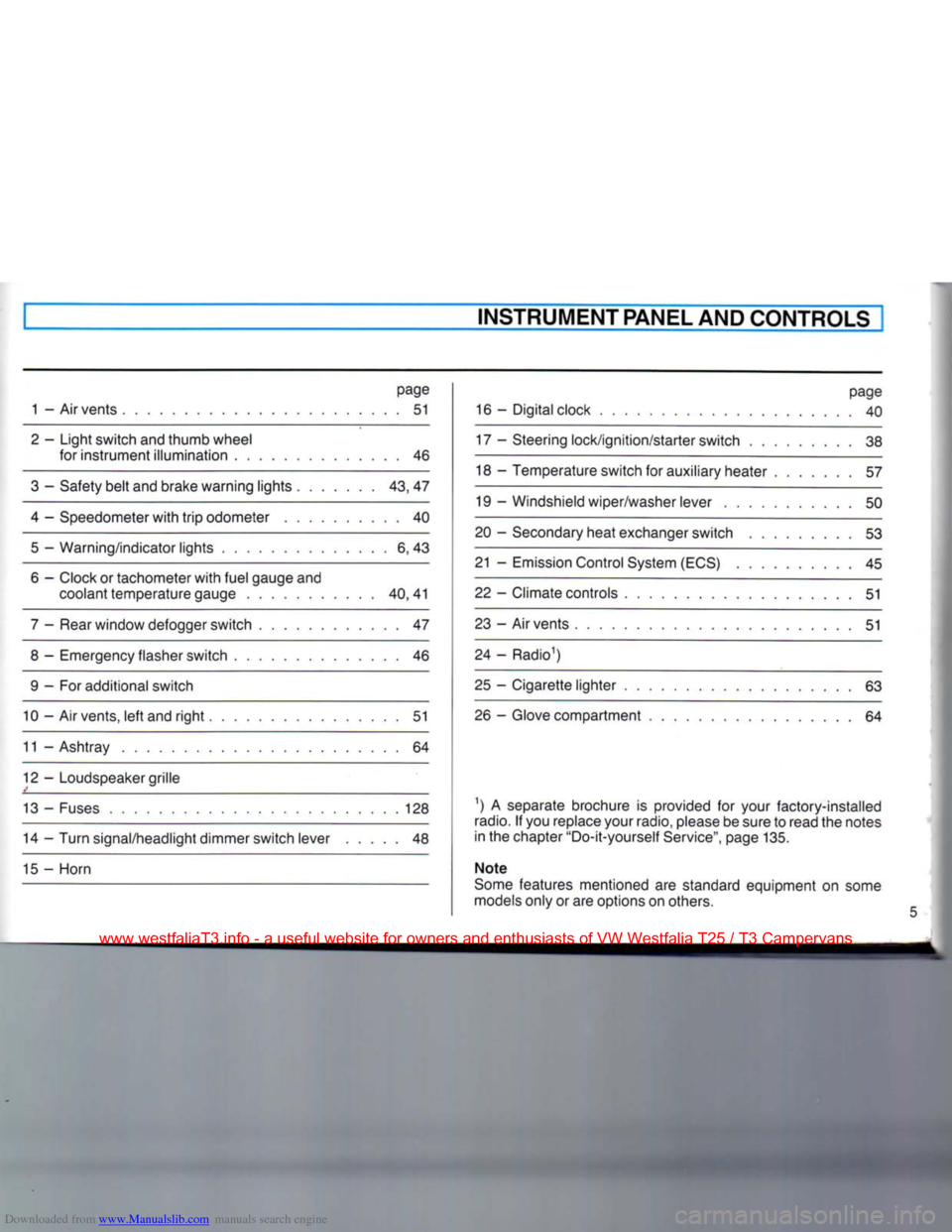
Downloaded from www.Manualslib.com manuals search engine
INSTRUMENT PANEL AND CONTROLS
page
1 - Air vents 51
2 - Light switch and thumb wheel for instrument illumination 46
3 - Safety belt and brake warning lights 43, 47
4 - Speedometer with trip odometer 40 5 — Warning/indicator lights 6, 43
6 - Clock or tachometer with fuel gauge and coolant temperature gauge 40,41
7 - Rear window defogger switch 47
8 - Emergency flasher switch 46 9 - For additional switch
10 - Air vents, left and right 51
11 - Ashtray 64
12 - Loudspeaker grille
13 - Fuses 128 14 - Turn signal/headlight dimmer switch lever 48
15 - Horn page
16 - Digital clock 40
17 - Steering lock/ignition/starter switch 38
18 - Temperature switch for auxiliary heater 57
19 - Windshield wiper/washer lever 50
20 - Secondary heat exchanger switch 53
21 - Emission Control System (ECS) 45
22 - Climate controls 51
23 - Air vents 51
24 - Radio1)
25 - Cigarette lighter 63 26 - Glove compartment 64
1) A separate brochure is provided for your factory-installed
radio.
If you replace your radio, please be sure to read the notes
in the chapter "Do-it-yourself Service", page 135.
Note
Some features mentioned are standard equipment on some
models only or are options on others.
www.westfaliaT3.info - a useful website for owners and enthusiasts of VW Westfalia T25 / T3 Campervans
Page 7 of 165
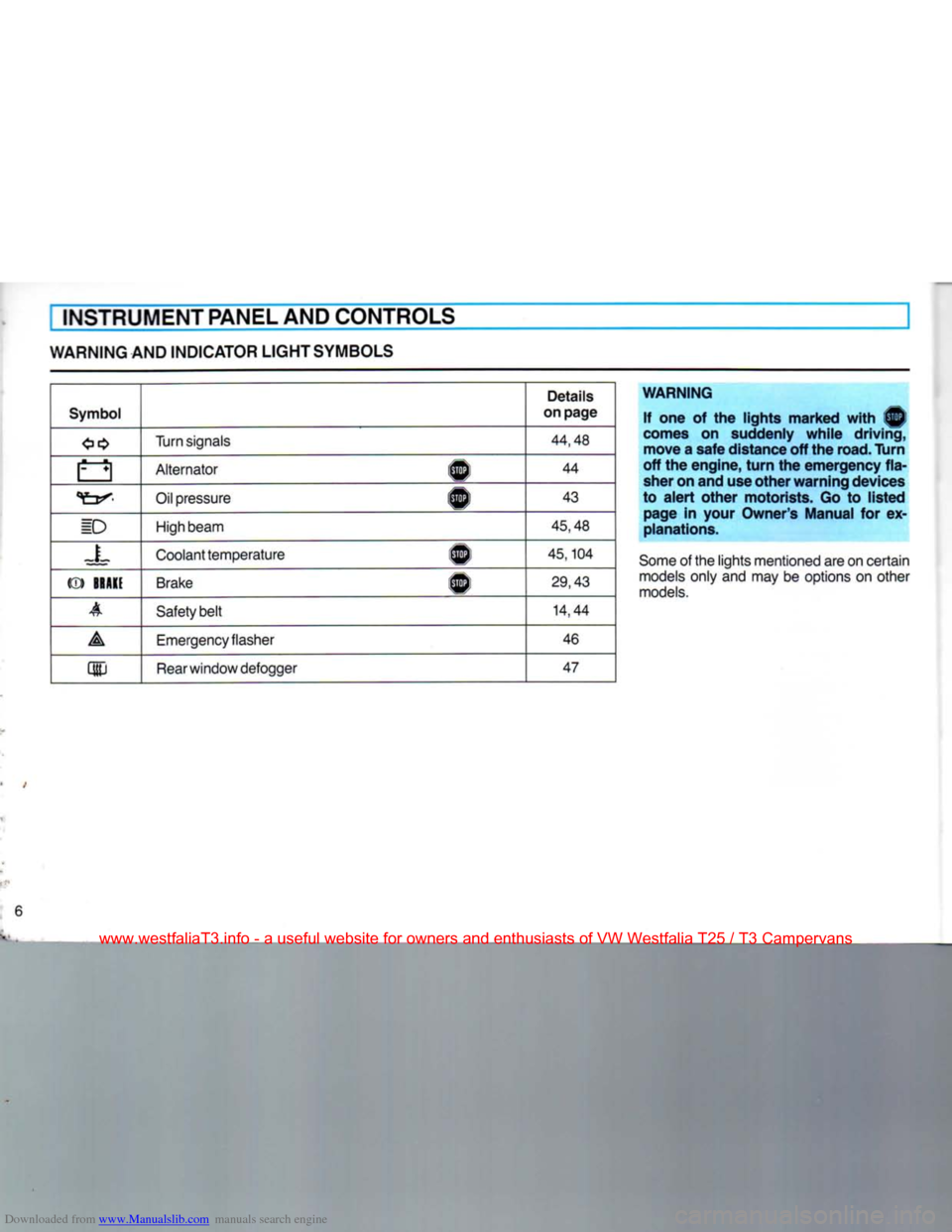
Downloaded from www.Manualslib.com manuals search engine
[INSTRUMENT
PANEL
AND
CONTROLS
WARNING AND
INDICATOR
LIGHT
SYMBOLS
Symbol
Details
on
page
Turn
signals
44,48
a Alternator A
44
Oil pressure 1^1
43
ID
High beam
45,48
=L Coolant temperature 1^
45,104
(®)
BRAKE
Brake
®
29,43
A Safety belt
14,44
A Emergency flasher
46
m
Rear
window defogger
47
WARNING
If one of the lights marked with ®
comes
on suddenly while driving, move a safe distance off the
road.
Turn
off the engine,
turn
the emergency
fla
sher on and use other warning devices
to alert other motorists. Go to listed page in
your
Owner's
Manual for ex
planations.
Some
of the lights mentioned are on certain
models
only and may be options on other
models.
6
www.westfaliaT3.info - a useful website for owners and enthusiasts of VW Westfalia T25 / T3 Campervans
Page 14 of 165
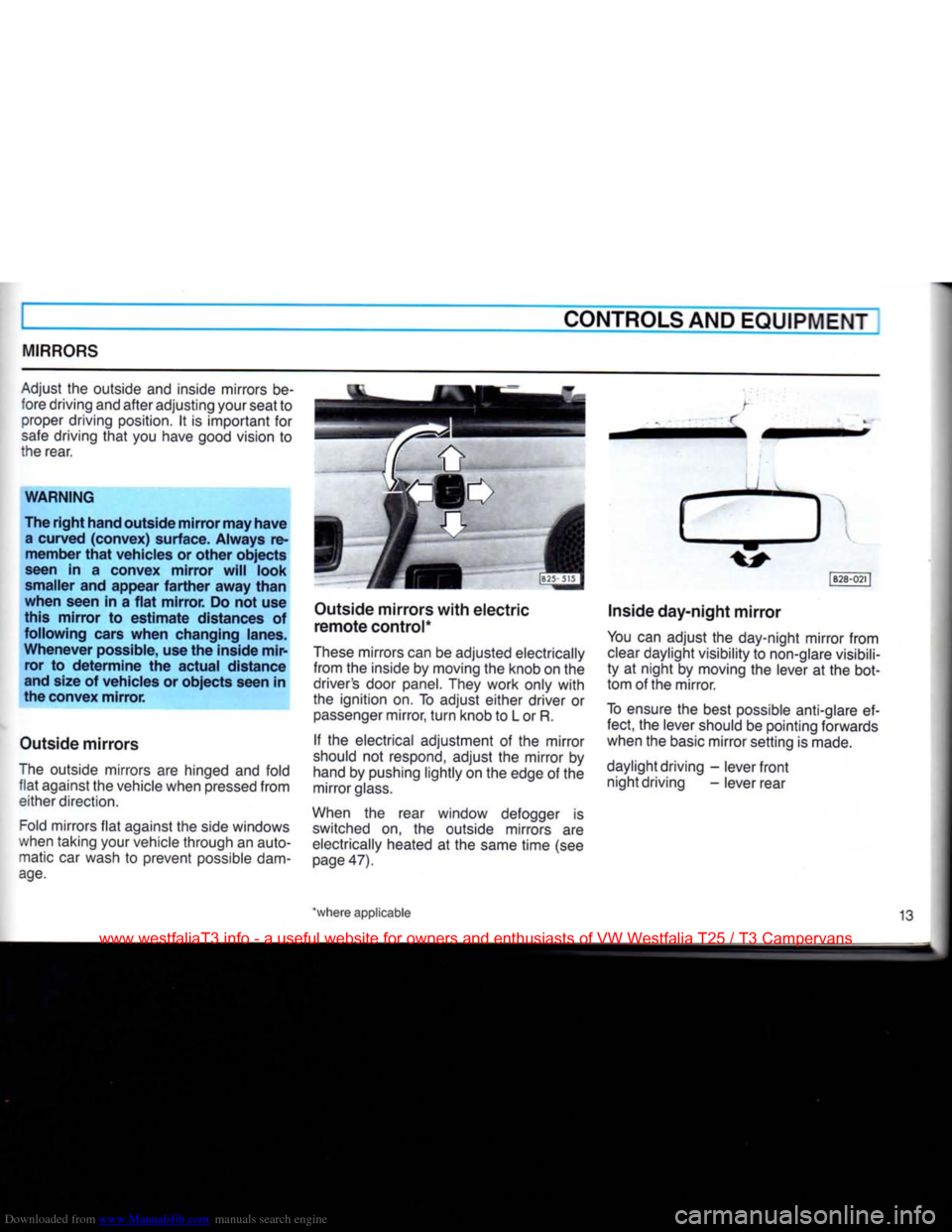
Downloaded from www.Manualslib.com manuals search engine
CONTROLS AND EQUIPMENT
MIRRORS
Adjust
the
outside
and
inside mirrors
be
fore driving and after adjusting your seat
to
proper driving position.
It is
important
for
safe driving that
you
have good vision
to
the rear.
WARNING
The right hand outside mirror may have a curved (convex) surface. Always remember that vehicles or other objects
seen in a convex mirror will look
smaller and appear farther away than
when seen in a flat mirror. Do not use
this mirror to estimate distances of
following cars when changing lanes.
Whenever possible, use the inside mir ror to determine the actual distance
and size of vehicles or objects seen in
the convex mirror.
Outside mirrors
The outside mirrors
are
hinged
and
fold flat against
the
vehicle when pressed from either direction.
Fold mirrors flat against
the
side windows
when taking your vehicle through
an
auto matic
car
wash
to
prevent possible dam
age.
Outside mirrors with electric
remote control*
These mirrors can
be
adjusted electrically from
the
inside
by
moving
the
knob
on the
driver's door panel. They work only with
the ignition
on. To
adjust either driver
or
passenger mirror, turn knob
to L or R.
If
the
electrical adjustment
of the
mirror
should
not
respond, adjust
the
mirror
by
hand
by
pushing lightly
on the
edge
of the
mirror glass.
When
the
rear window defogger
is
switched
on, the
outside mirrors
are
electrically heated
at the
same time
(see
page 47). |B28-021
|
Inside day-night mirror
You
can
adjust
the
day-night mirror from clear daylight visibility
to
non-glare visibili
ty
at
night
by
moving
the
lever
at the
bot
tom
of
the mirror.
To ensure
the
best possible anti-glare
ef
fect,
the
lever should
be
pointing forwards
when
the
basic mirror setting
is
made.
daylight driving
-
lever front night driving
-
lever rear
*where applicable 13
www.westfaliaT3.info - a useful website for owners and enthusiasts of VW Westfalia T25 / T3 Campervans
Page 19 of 165
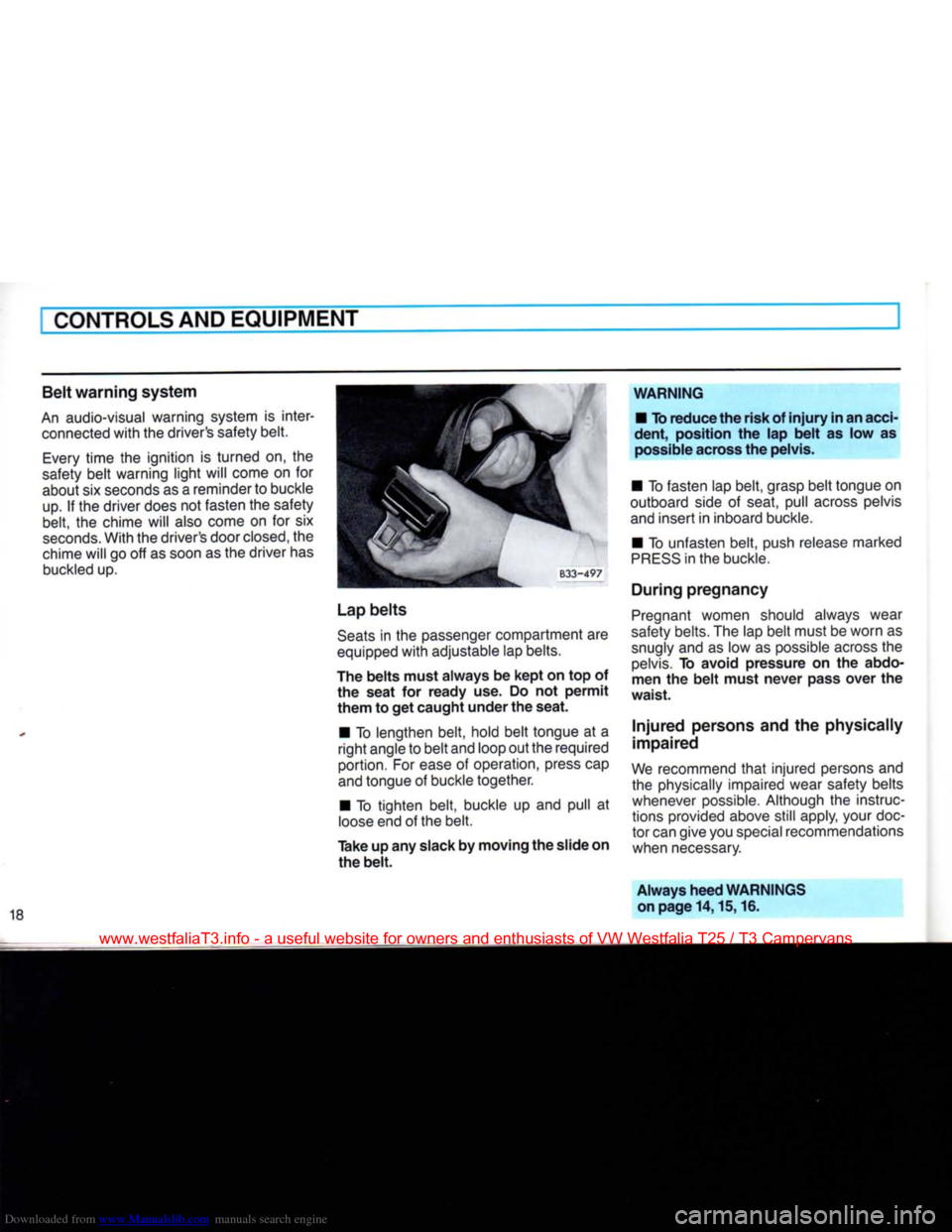
Downloaded from www.Manualslib.com manuals search engine
CONTROLS AND EQUIPMENT
Belt
warning
system
An
audio-visual warning system is inter
connected
with
the driver's safety belt.
Every
time the ignition is turned on, the
safety belt warning light will come on for about six seconds as a reminder to buckle
up.
If the driver does not fasten the safety
belt, the chime will also come on for six
seconds.
With the driver's door
closed,
the
chime will go off as soon as the driver has
buckled
up.
Lap
belts
Seats
in the passenger compartment are
equipped
with
adjustable lap belts.
The
belts
must
always
be
kept
on top of the
seat
for
ready
use. Do not
permit
them
to get
caught
under
the
seat.
• To lengthen belt, hold belt tongue at a
right
angle to belt and loop out the required
portion. For
ease
of operation, press cap
and
tongue of buckle together.
• To tighten belt, buckle up and pull at
loose
end of the belt.
Take
up any slack by
moving
the slide on the
belt.
WARNING
• To
reduce
the
risk
of
injury
in an acci
dent,
position the lap
belt
as low as
possible across the pelvis.
• To fasten lap belt, grasp belt tongue on
outboard side of seat, pull across pelvis
and
insert in inboard buckle.
• To unfasten belt, push release marked
PRESS
in the buckle.
During
pregnancy
Pregnant
women should always wear
safety belts. The lap belt must be worn as
snugly and as low as possible across the
pelvis.
To avoid pressure on the abdo
men the
belt
must
never
pass
over
the
waist.
Injured
persons and the physically
impaired
We
recommend
that
injured persons and the physically impaired wear safety belts
whenever possible. Although the instruc
tions provided above still apply, your doc
tor can give you special recommendations
when necessary.
Always
heed
WARNINGS
on
page
14,15,16.
www.westfaliaT3.info - a useful website for owners and enthusiasts of VW Westfalia T25 / T3 Campervans
Page 21 of 165
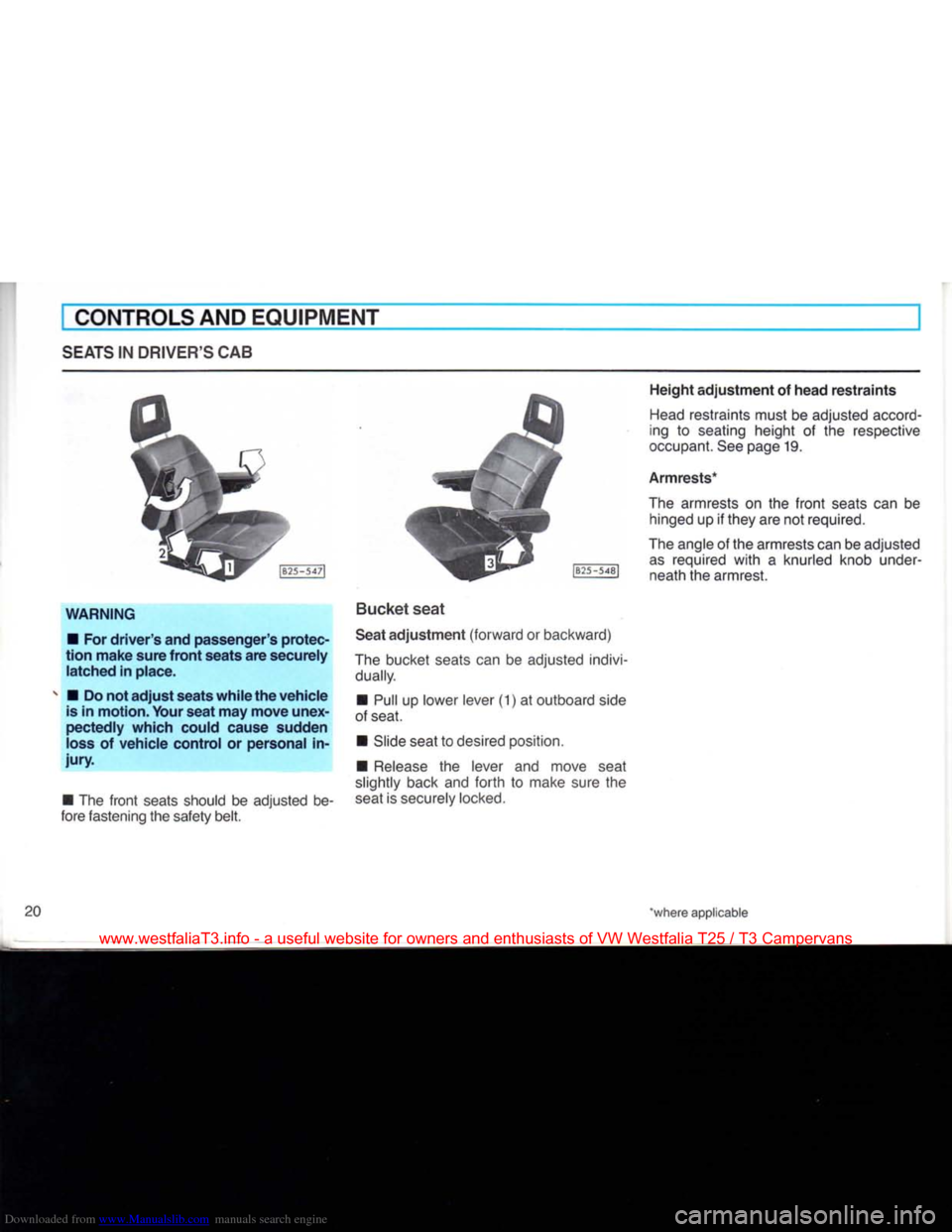
Downloaded from www.Manualslib.com manuals search engine
CONTROLS
AND
EQUIPMENT
SEATS
IN
DRIVER'S
CAB
WARNING
•
For
driver's
and passenger's
protec
tion
make
sure
front
seats
are
securely
latched
in place.
*
• Do not
adjust
seats
while
the
vehicle
is in
motion.
Your
seat
may
move
unex
pectedly
which
could cause sudden
loss of
vehicle
control
or
personal
in
jury.
•
The
front
seats should be adjusted be
fore fastening the safety belt.
B25-548
Bucket
seat
Seat
adjustment
(forward
or backward)
The
bucket seats can be adjusted indivi dually.
•
Pull up lower lever (1) at outboard side
of seat.
•
Slide seat to desired position.
•
Release
the lever and move seat
slightly back and
forth
to make sure the
seat
is securely locked.
Height
adjustment
of
head
restraints
Head
restraints must be adjusted accord
ing to seating height of the respective
occupant. See page 19.
Armrests*
The
armrests on the
front
seats can be hinged up if they are not required.
The
angle of the armrests can be adjusted
as
required
with
a knurled knob underneath the armrest.
*where applicable
www.westfaliaT3.info - a useful website for owners and enthusiasts of VW Westfalia T25 / T3 Campervans
Page 22 of 165
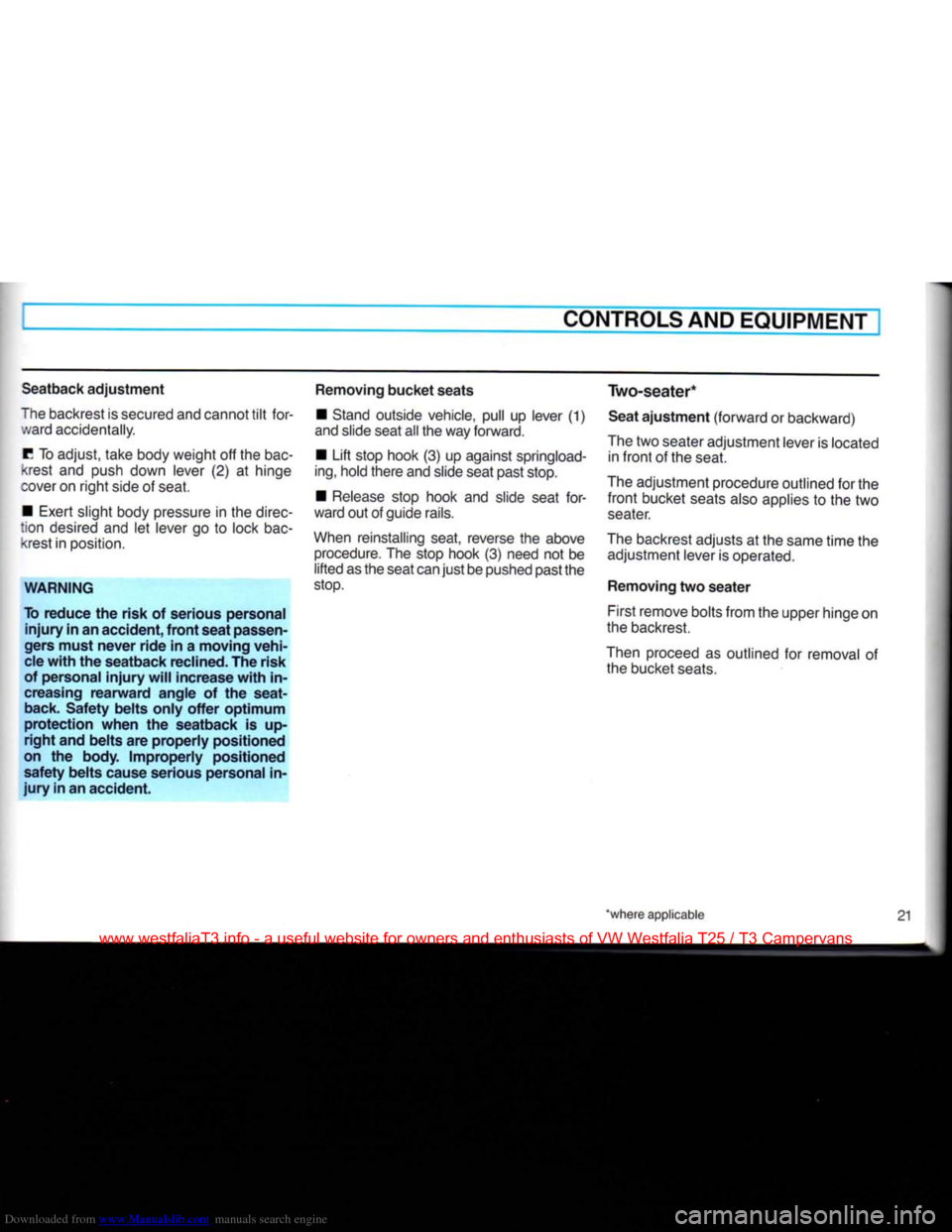
Downloaded from www.Manualslib.com manuals search engine
CONTROLS AND
EQUIPMENT
Seatback
adjustment
The backrest is secured and cannot
tilt
for
ward accidentally.
C
To adjust, take body weight off the
bac
krest and push down lever (2) at hinge
cover on
right
side of seat.
• Exert slight body pressure in the direc
tion
desired and let lever go to lock
bac
krest in position.
WARNING
To
reduce
the
risk
of
serious
personal
injury
in an
accident,
front
seat
passen
gers
must
never
ride
in a
moving
vehi
cle
with
the
seatback
reclined.
The
risk
of
personal
injury
will
increase
with
in
creasing
rearward
angle
of the
seat-
back.
Safety
belts
only
offer
optimum
protection
when
the
seatback
is up
right
and
belts
are
properly
positioned
on the
body.
Improperly
positioned
safety
belts
cause
serious
personal
in
jury
in an
accident.
Removing
bucket
seats
• Stand outside vehicle, pull up lever (1)
and slide seat all the way forward.
•
Lift
stop hook (3) up against springload-
ing,
hold there and slide seat past stop.
•
Release
stop hook and slide seat
for
ward out of guide rails.
When reinstalling seat, reverse the above procedure. The stop hook (3) need not be
lifted
as the seat can
just
be pushed past the
stop.
Two-seater*
Seat
ajustment
(forward
or backward)
The two seater adjustment lever is located in
front
of the seat.
The adjustment procedure outlined for the
front
bucket seats also applies to the two
seater.
The backrest adjusts at the same
time
the adjustment lever is operated.
Removing
two
seater
First remove bolts
from
the upper hinge on
the backrest.
Then proceed as outlined for removal of the bucket
seats.
*where applicable 21
www.westfaliaT3.info - a useful website for owners and enthusiasts of VW Westfalia T25 / T3 Campervans
Page 23 of 165
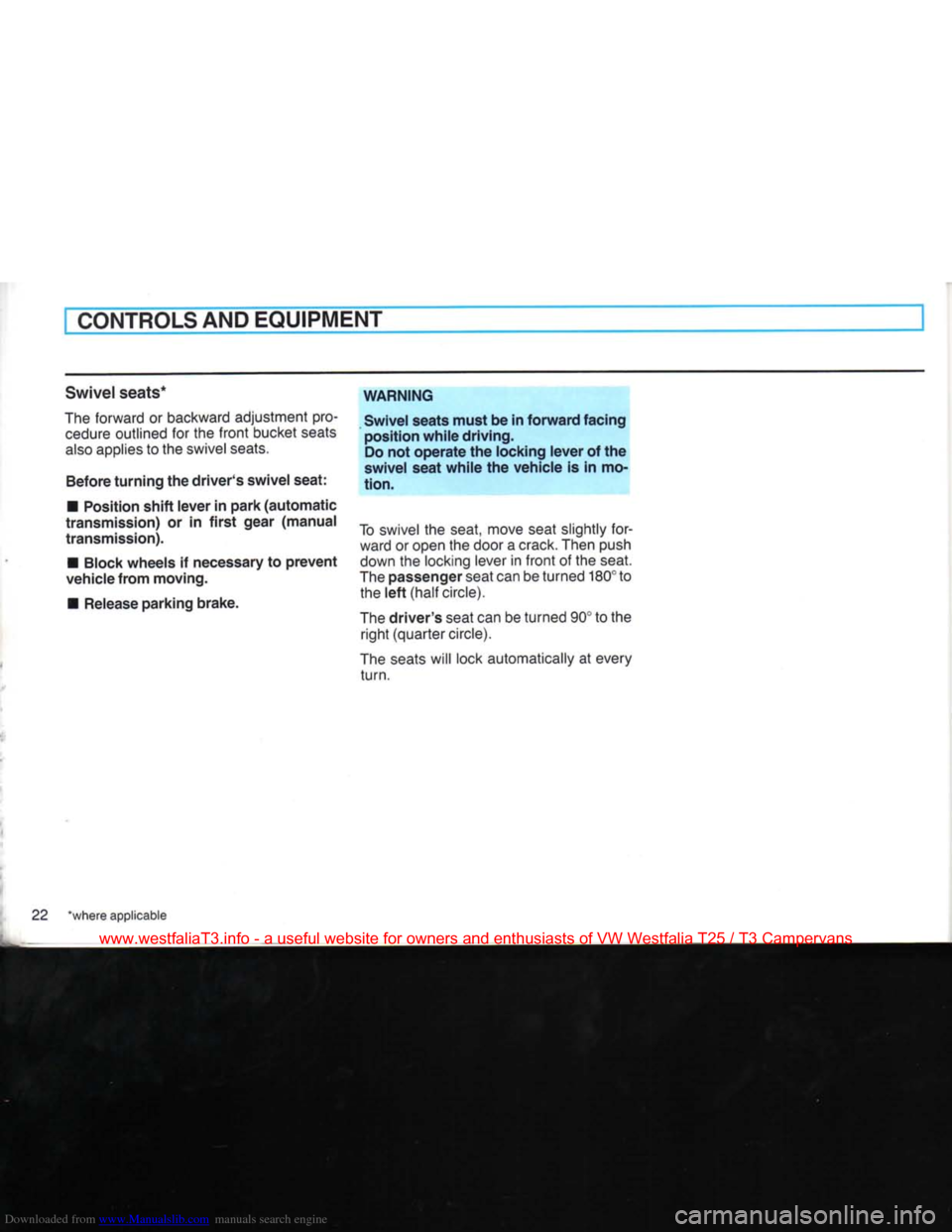
Downloaded from www.Manualslib.com manuals search engine
CONTROLS
AND
EQUIPMENT
Swivel seats*
The forward or backward adjustment pro cedure outlined for the
front
bucket seats
also
applies to the swivel seats.
Before turning the driver's swivel seat:
•
Position shift lever in park (automatic
transmission) or in first gear (manual
transmission).
•
Block wheels if necessary to
prevent
vehicle from moving.
•
Release parking brake. WARNING
Swivel seats must be in forward facing
position while driving. Do not operate the locking lever of the
swivel seat while the vehicle is in mo
tion.
To swivel the seat, move seat slightly for ward or open the door a crack.
Then
push
down the locking lever in
front
of the seat.
The passenger seat can be turned
180°
to the left
(half
circle).
The driver's seat can be turned
90°
to the
right
(quarter
circle).
The seats will lock automatically at
every
turn.
22
"where applicable
www.westfaliaT3.info - a useful website for owners and enthusiasts of VW Westfalia T25 / T3 Campervans